Claussen Pickles are kosher dill pickles at their crunchiest, saltiest best! These homemade Claussen pickles taste like the commercial ones you find at the store, but better. And better yet, they’re ridiculously easy to make!
Whether you’re new to pickle making or a pickle veteran, you NEED to make these half sour pickles! And wonder of wonders, you don’t need to know how to can to make these super fresh, crunchy pickles! Claussen dill pickles are meant to be eaten fresh.
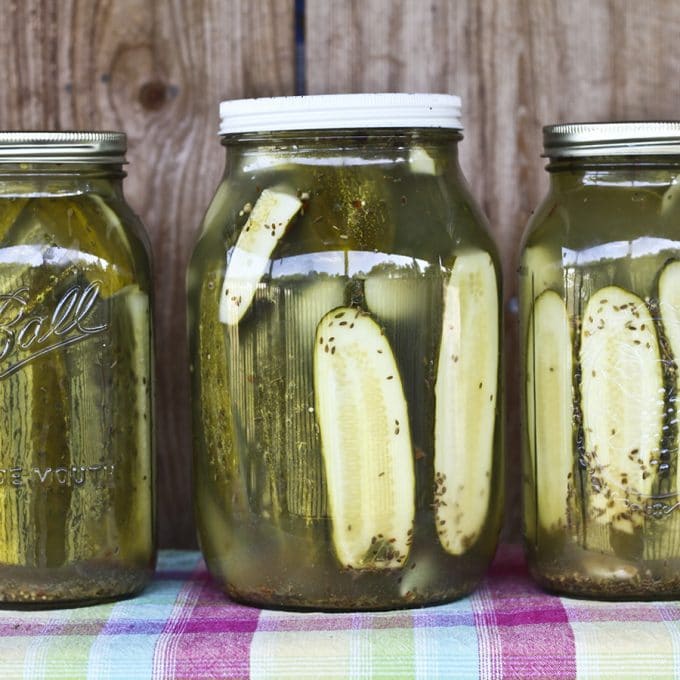
Homemade Claussen Knock-Off Pickles: Always crunchy and garlicky, this perfect homemade pickle recipe requires no special equipment, & no canning experience.
It’s common knowledge that I have a salty tooth rather than a sweet tooth. When the weather does what it has been doing lately (making us all do our best Shadrach, Meshach and Abednego impersonations) I can’t think of a single thing I find more refreshing than an icy-cold, salty, crunchy pickle.
It’s not just me, it’s my whole family: mother, sisters, brothers, cousins, aunts, grandparents, kids, husband… I married a man who loves pickles so much he eats the pickles and then drinks the juice from the jar.
I grew up eating my Grandma’s homemade dill pickles like the supply was endless and moved on to canning my own pickles as soon as I had a kitchen of my own. There’s just something about a homemade dill pickle that makes me happier than any pickled cucumber ever should.
My little sister, Jessamine, and I compare our homemade pickles from year to year the way some people compare wine vintages.
Dill Pickle Recipe
But there is one pickle that stands head-and-shoulders (were pickles to *have* heads and shoulders) above all others. I’m talking about the pickles you see here. That’s right: Homemade Claussen Dill Pickles.
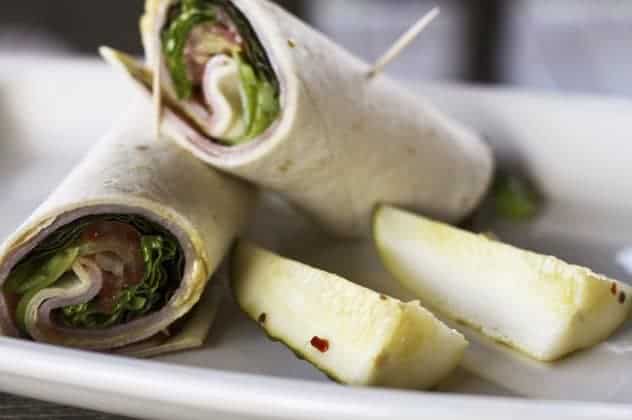
Recipe for Claussen Pickles
What do you need in order to make this recipe for Claussen Half Sour Pickles at home? Let’s get a quick list for both ingredients and equipment out of the way, shall we?
Equipment for Making Claussen Pickles at Home
- A Glass gallon jar or 4 glass quart jars or other food safe container with a tight fitting lid
- Measuring cup
- Chef’s knife or paring knife
Ingredients for Making Homemade Claussen Pickles Copycat
- Small to medium size pickling cucumbers (check your local farm stand or farmer’s market!)
- Apple Cider Vinegar (don’t fret- it doesn’t taste like apple cider and isn’t even a little sweet!) or white vinegar
- Kosher Salt
- Garlic
- Dill (either fresh or dill seed)
- Pickling spices (available here)
A quite note on your vinegar choice: I opt for apple cider vinegar because it’s a smoother vinegar than white vinegar. It does not impart any sweetness or apple taste to the pickles whatsoever.
If you can’t find it (pssst. It’s right next to white vinegar in even moderately stocked grocery stores) or don’t feel like buying it, you can most certainly substitute white vinegar. It’ll just taste a little sharper. (And technically store bought Claussen pickles have white vinegar, so you do you!)
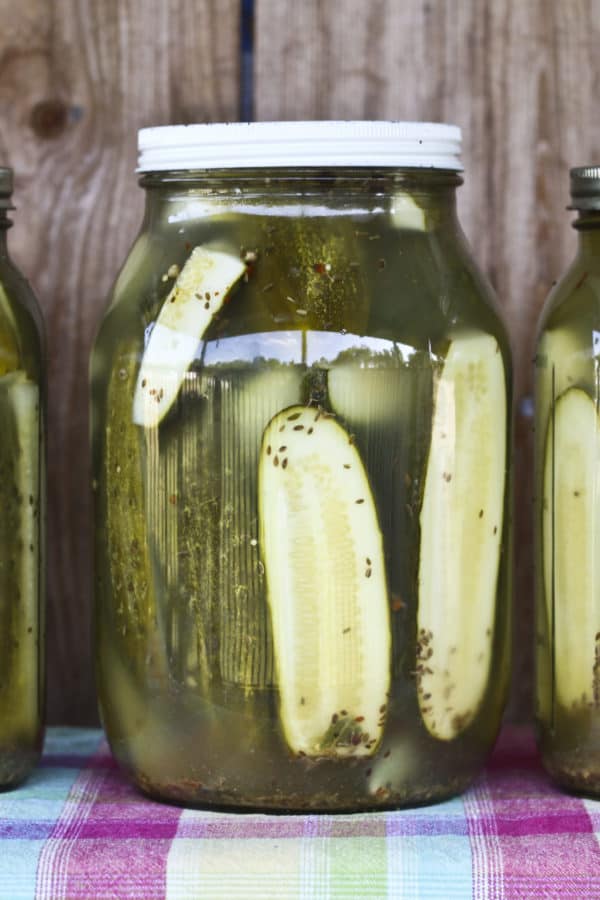
And ya’ll. These homemade half sour pickles are so easy to make it’s almost criminal.
The hardest part is the 2 to 4 day wait for them to be done. Truth be told, though, I’ve snacked on them the day after I made them and been a very happy camper.
Claussen Pickle Recipe
These are homemade refrigerated deli pickles, also known as Lithuanian half-sours, also known (in the commercial equivalent) as Claussen dill kosher pickles, also known as the best pickles ever known to mankind.
Here’s the thing. While I do love my other homemade pickles dearly (otherwise why would I continue canning ninety-something quarts year after year after year), these are by far my all-time favourites.
CRUNCH. That’s what you hear when you bite these. There is no flop, no squish, no soft pickles. These things almost bite back.
This also happens to be the perfect dill pickle recipe for beginning pickle makers. If you’re not into canning, these refrigerator pickles are a godsend. Even if you ARE canning obsessed, like yours truly, this Claussen pickle recipe should be in your pickle repertoire too.
Please note that this Claussen pickle recipe is not suitable for canning. The brine is fermented and not very acidic, which means it has far too high a PH to can safely. If you’re looking for a great canned dill pickle recipe, try this home canned garlic dill pickle recipe.
Refrigerator Pickles
Here’s where we get into the best part of this pickle recipe (aside from the crunch and flavor). You don’t have to cook anything to make these pickles; not one single thing. The brine is stirred together, the cucumbers are rinsed, trimmed and stuffed into a jar with garlic cloves and spices.
These half sour pickles are NOT CANNED. They are simply put into jars. Amen!
When it’s summer time and the idea of turning on the stove makes me want to crawl into an (air conditioned) hole, these pickles are a welcome treat. Not only is that cold crunchy refrigerator pickle waiting to cool me off at the end of the prep time, but I don’t have to heat up my kitchen by even one single degree to get there.
Remember that pickling isn’t just for cucumbers, either! Try out our Pickled Brussels Sprouts, Quick Pickled Red Onions, and famous Candied Jalapenos!
How to Make Pickles FAQ
Please, please, please give these a go even if you have never made a pickle before. There is nothing scary or intimidating here. Wash, slice, stuff, stir, pour, sit, wait.
- Trim 1/8-inch from the blossom end of each cucumber and slice them in half lengthwise or into quarters. The size you choose depends on how large your cucumbers are and how big you want the pickles to be when they’re done. This helps minimize the chances of soft pickles.
- In a gallon jar (or large, wide-mouth, food-safe container) layer the dill heads or seed, pickling spice or mustard seed, and garlic cloves and sliced cucumbers. If you’re dividing the cucumbers up between smaller containers, just divide the garlic and spices evenly between the containers, too.
- Stir your brine together in a separate container. You WILL have more brine than you have space for in the jars, but that’s why you pack the spices in the jars. Just store extra brine in a jar in the refrigerator and use it to top off your pickles if the brine starts evaporating.
- Pour the brine over the cucumbers, taking care to make sure all of them are fully submerged. If needed, place a plate or mug or other ziploc bagged can of beans on the cucumbers to weigh them down and keep them under the brine!
- Cover the jars lightly not tightly and leave out of direct sunlight on the counter for two to four days or until the pickles are picklicious.
- If your kitchen is pretty hot or humid, you can stash them directly in the refrigerator. They’ll just take a couple of days longer to get fabulous. Your patience will be rewarded.
On the plus side, the wait is only two to four days which is significantly less than the six week wait of the canned pickles. Besides, as I said, there is the crunch factor
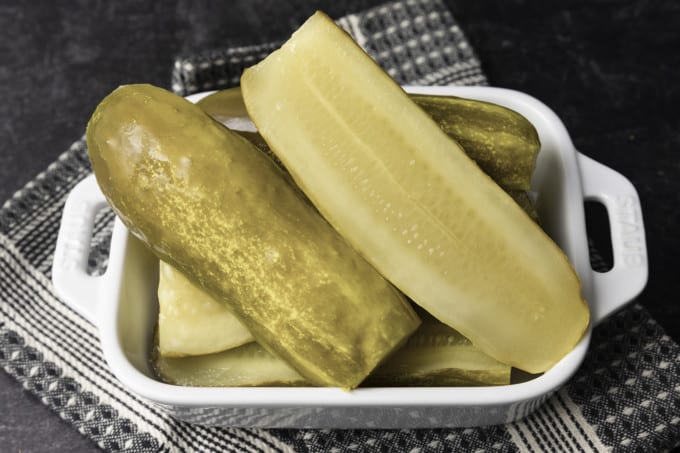
Troubleshooting Your Homemade Claussen Pickles
These pickles are easy peasy to make, but there still may be a couple of things that pop up from time to time that make you go “Hmmm…” In no particular order, here are some of the most commonly asked questions about them and some answers!
- Why is my pickle brine cloudy? Okay, I lied. This is the most common question and that’s because the brine becomes cloudy naturally as a consequence of fermentation (which is what’s happening here.) No worries.
It’s all natural. This half sour pickle recipe (more on this to come) is a fermented pickle recipe and that just happens.
Another possible cause of intense cloudiness or discolouration in your brine is using table salt. The iodine in table salt can also give off flavours to your pickles, so it’s best to stick with kosher salt or pickling salt for these bad boys! - Is the scum, foam, or film on top of my pickle brine dangerous? It’s that pesky (and delicious) fermentation again! This is another thing you don’t have to worry about.
Just scrape it off with a spoon, discard, and top off with a little of that extra brine you whipped up. (See the recipe card for details.) But do remove the scum or it could cause your pickles to go bad. - My pickles went soft! How do I prevent this? This particular tragedy could have two causes.
First, you may have failed to remove enough of the blossom end of the cucumber. There is a naturally occurring enzyme in the blossom end of cucumbers that causes pickles to break down and become soft if it is not removed. Next time, just slice more off.
Second, you may have started with less than spectacularly fresh cucumbers. An older cucumber has had longer for the aforementioned enzyme to kick in, and it has already started its work.
The best solution for this issue is to use cucumbers that have either been picked fresh that day or have been refrigerated steadily since very shortly after being picked a couple of days previously. - Why did my pickles go bad? See that second reason in the “why did my pickles go soft” bullet point? That’s one culprit.
Other potential causes of spoiled pickles are using unwashed cucumbers or fresh dill, old or decayed garlic, bad spices, lower-than-5%-acidity-vinegar, failing to remove the scum from the brine or to keep the pickles submerged in the brine, or storing your pickles in warmer conditions. When in doubt, stash them in the refrigerator! - Why is there mold on my pickles? First, you have my condolences. Second, it’s because your pickles didn’t stay submerged in the brine. That brine has enough salt and acid to prevent mold growth if the cucumbers stay under the surface.
If you’re having trouble finding something that fits in the jar to keep this from happening, try popping a can or two of tomato paste or canned beans in a zipper top bag and gently inserting that into the jar. It should weigh it down enough to do the job. - Should I worry about the white sediment in my jar? This is another one in the “don’t sweat it” category. There are two potential reasons and both are completely harmless.
It’s either a natural consequence of the fermentation or anti-caking agents in the salt. Neither harms the pickles or effects the flavour, so don’t worry! - Why is my garlic blue/green/purple? As long you inspect the garlic before it goes into your jars and it is fresh as a daisy, you have nothing to worry about. It could be the type of salt you used or it could be the variety of garlic. Some types of garlic have a natural propensity to change pretty colours in vinegar.
It also may mean that your pickles were exposed to light. When garlic is exposed to light, it starts producing chlorophyll which is green. It also may indicate that your garlic is more mature.
In that case it is caused by sulfur compounds that naturally occur in more mature garlic reacting with minute traces of copper in the vinegar., but as long as there are no other signs of spoilage (soft or squishy texture, funky smell, discoloured spots), you’re good to go.
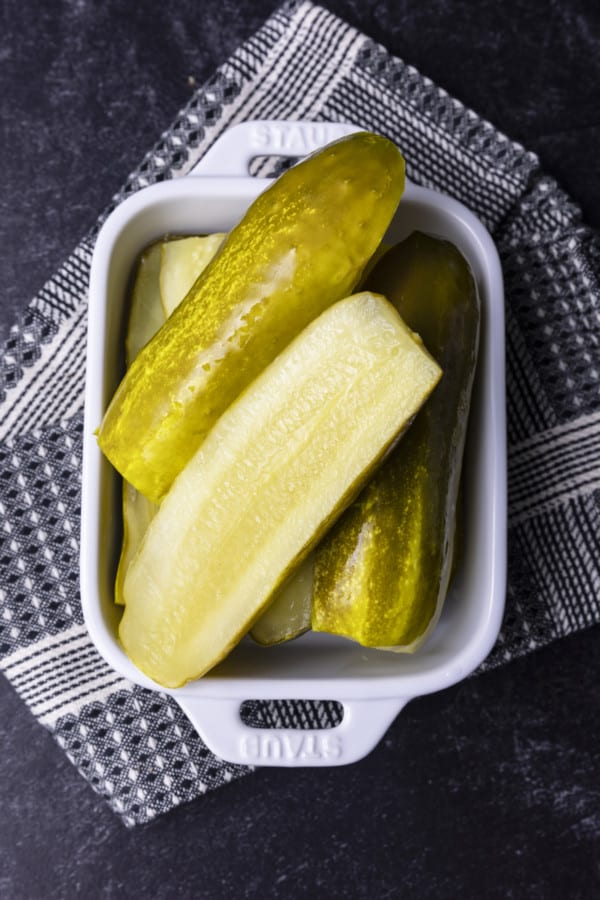
IMPORTANT NOTE: Because there is so much diversity in temperature, humidity, age of cucumbers, etc… involved in this recipe, please check your half sour pickles starting at 24 hours for doneness. If the pickles smell/taste pickley, move them to the refrigerator. Do not keep them on the counter longer than 4 days.
ANOTHER IMPORTANT NOTE: These pickles are not suitable for canning. They’re simply not acidic enough to can safely, and that is in addition to the fact that you’d ruin that perfectly crisp texture by introducing heat to the party.
What can I serve with these Homemade Claussen Knock-Off Pickles?
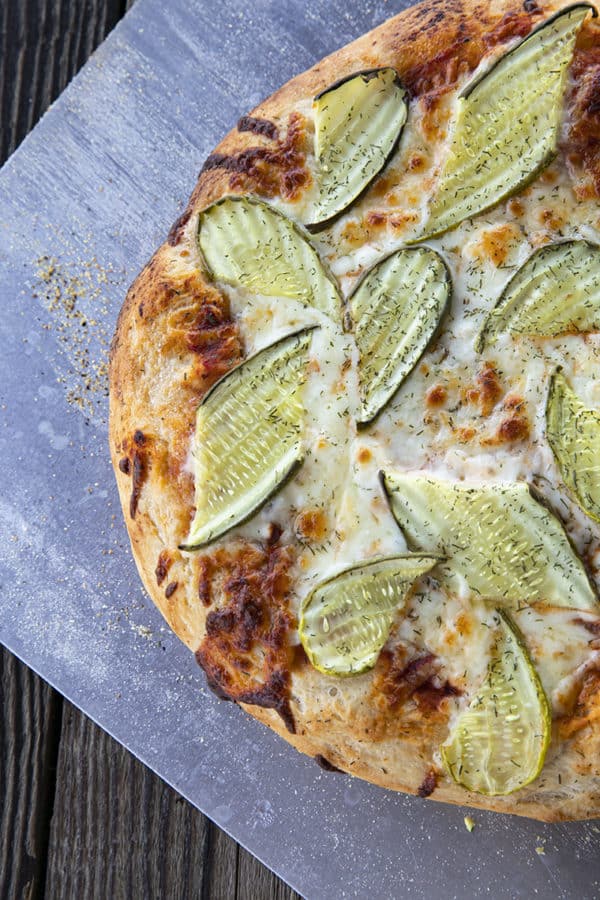
Start out by trying your half sour pickles in this Pickle de Gallo, Dill Pickle Dip, Dill Pickle Egg Salad, or Bagel Burgers with Dill Pickle Cream Cheese.
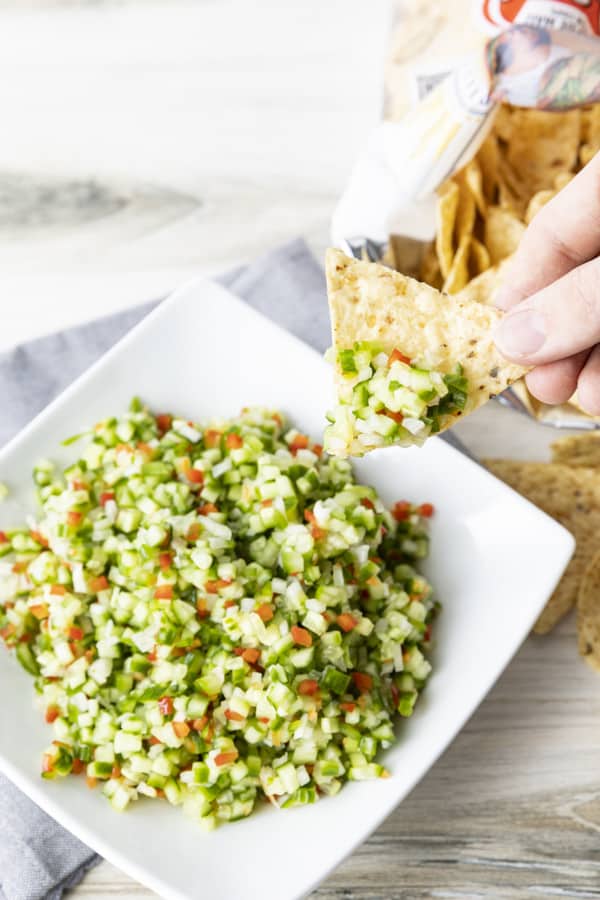
Even better, serve them on our Cheeseburger Salad or Pickle Pizza.
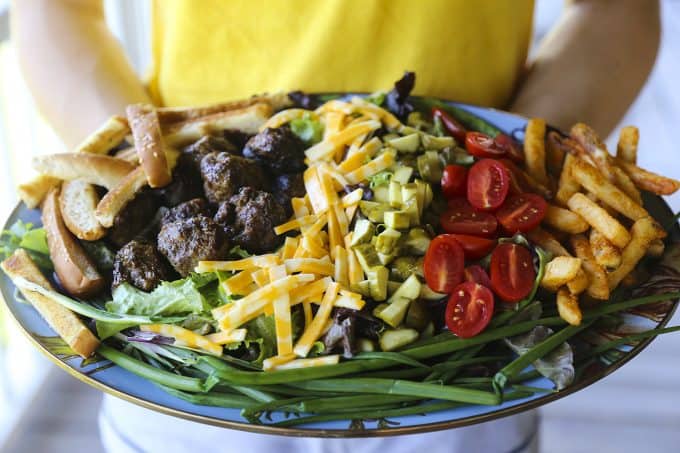
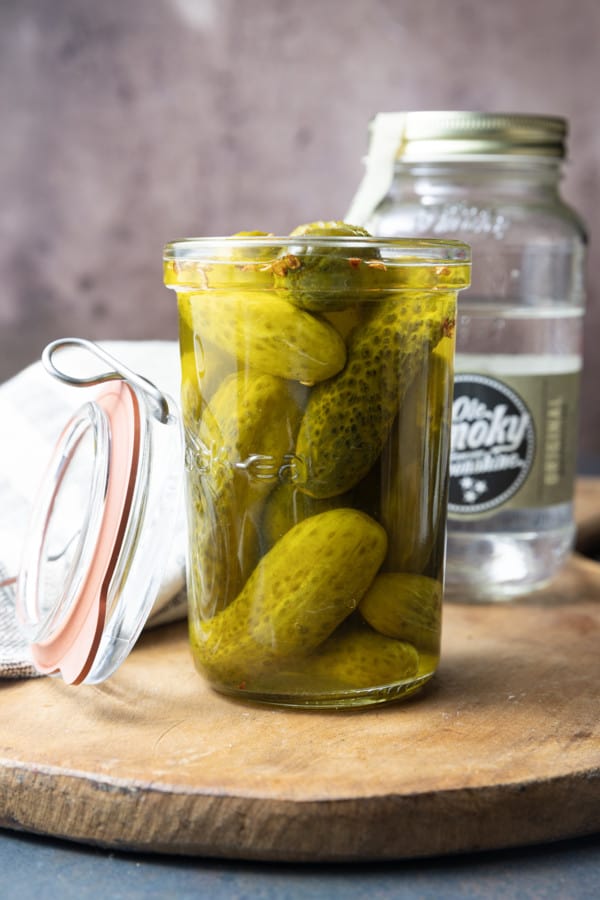
You can even take extra pickles (like that’s a thing!) and make these divine Moonshine Pickles. You’ve never had a better Bloody Mary than one made with homemade Moonshine Pickles!
Half Sour Pickle Recipe
What makes Claussen PIckles different from canned pickles? Claussen pickles, whether homemade or store bought, are a half sour pickle recipe.
That means they’re fermented instead of heat processed. That’s what gives them such great texture.
This half sour pickle recipe yields pickles that are crunchy to the point of making noise when you bite them, cold, and seriously garlicky. Canned, shelf-stable pickles can be chilled, maintain some crunch, and be as garlicky as you want them to be, but they are never, ever going to be the same thing because of science.
When you heat process a jar of pickles you are, in actuality, cooking it and a cooked pickle just plain can’t be as crunchy as an un-cooked half sour pickle recipe.
These homemade pickles keep well in the fridge for about six months, as long as they remain submerged in the brine. In our house, they never last that long because, as the saying goes, “A pickle a day keeps sad times away.”
They say that right? Someone must. If not, I’m going to start. It’s true, after all.
Claussen Pickles
Wash cucumbers but do not scrub them.
Trim 1/8-inch to 1/4-inch from the blossom end of each cucumber and slice in half lengthwise or into quarters, depending on how large your cucumbers are and how big you want them to be when they’re done.
Layer the dill heads or seed, garlic cloves, pickling spices and sliced cucumbers in a gallon jar (or large, wide-mouth, food-safe container). You can evenly divide the dill, garlic cloves, pickling spices, and cucumbers between several smaller jars if needed.
In a separate pitcher or bowl, stir together the remaining ingredients until the salt is dissolved.
Pour the brine over the cucumbers, taking care to make sure all of them are fully submerged. If needed, place a plate or mug or other non-reactive heavy item on the cucumbers to weigh them down and keep them under the brine!
Cover lightly with a lid just perched on top or secure a piece of cheesecloth over the jar with a rubber band to keep fruit flies away. Store any extra brine in a covered jar or pitcher in the refrigerator and use it to top off the brine if it starts to evaporate and expose the pickles to the air.
Leave out of direct sunlight on the counter for at least 24 hours, but up to 4 days, or until the cucumbers taste like pickles throughout.
Fix your lid onto your jar or container and chill thoroughly. These can be stored in the refrigerator for up to six months provided you keep them covered with brine.
NOTE: If at any point in the proceedings “fuzz” or “foam” develops on top of the brine, use a spoon to remove it. If there is “fuzz” attached to any of the cucumbers, remove the ones affected and be sure the others are still fully submerged.
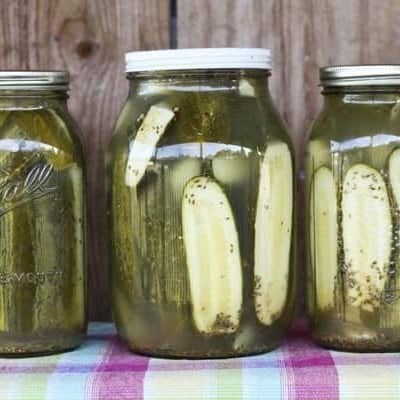
Homemade Claussen Knock-Off Pickles
Equipment
- 1 gallon jar or 4 quart jars or a large, food-safe container with a tight fitting lid
- 1 liquid measuring cup
- 1 large mixing bowl or pitcher
Ingredients
- 35 to 40 small to medium pickling cucumbers
- 1 gallon cold water
- 1 cup apple cider vinegar, preferably raw or white distilled vinegar
- 2/3 cup coarse canning or kosher salt Do NOT fine or use iodized salt!
- 4 cloves garlic or more to taste
- 4 heads fresh dill or 4 tablespoons dried dill seed not weed!
- 2 tablespoons mixed pickling spices
Instructions
- Wash cucumbers but do not scrub them.
- Trim 1/8-inch from the blossom end of each cucumber and slice in half lengthwise or into quarters, depending on how large your cucumbers are and how big you want them to be when they’re done.
- In a gallon jar (or large, wide-mouth, food-safe container) layer the dill heads or seed, garlic cloves, pickling spices and sliced cucumbers.
- In a separate pitcher or bowl, stir together the remaining ingredients until the salt is dissolved.
- Pour the brine over the cucumbers, taking care to make sure all of them are fully submerged. If needed, place a plate or mug or other non-reactive heavy item on the cucumbers to weigh them down and keep them under the brine!
- Cover lightly with a lid just perched on top or secure a piece of cheesecloth over the jar with a rubber band to keep fruit flies away.
- Leave out of direct sunlight on the counter for two to four days*, or until the cucumbers taste like pickles throughout.
- Fix your lid onto your jar or container and chill. These can be stored in the refrigerator for up to six months provided you keep them covered with brine.
- *If at any point in the proceedings “fuzz” or “foam” develops on top of the brine, use a spoon to remove it. If there is “fuzz” attached to any of the cucumbers, remove the ones affected and be sure the others are still fully submerged.
Notes
Nutrition
Nutritional information is an estimate and provided to you as a courtesy. You should calculate the nutritional information with the actual ingredients used in your recipe using your preferred nutrition calculator.
did you make this recipe?
Make sure to tag @foodiewithfam on Instagram and #hashtag it #foodiewithfamily so I can check it out!
Originally published July 22, 2011. Updated with FAQs and Troubleshooting and reposted August 2022.
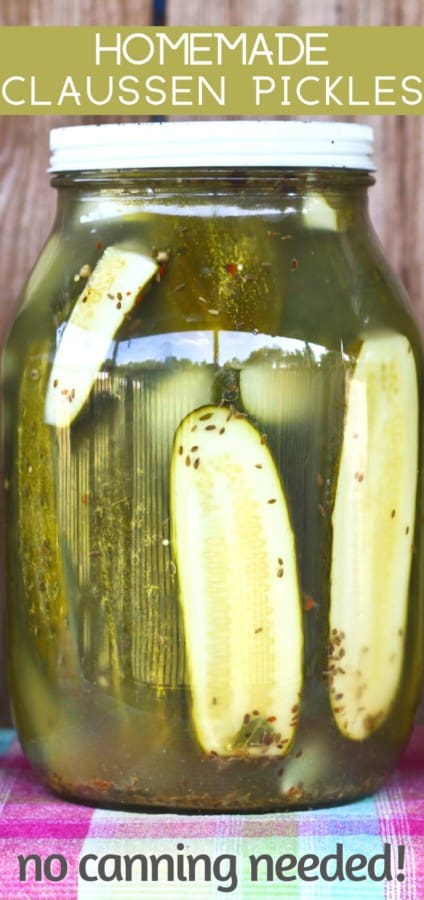
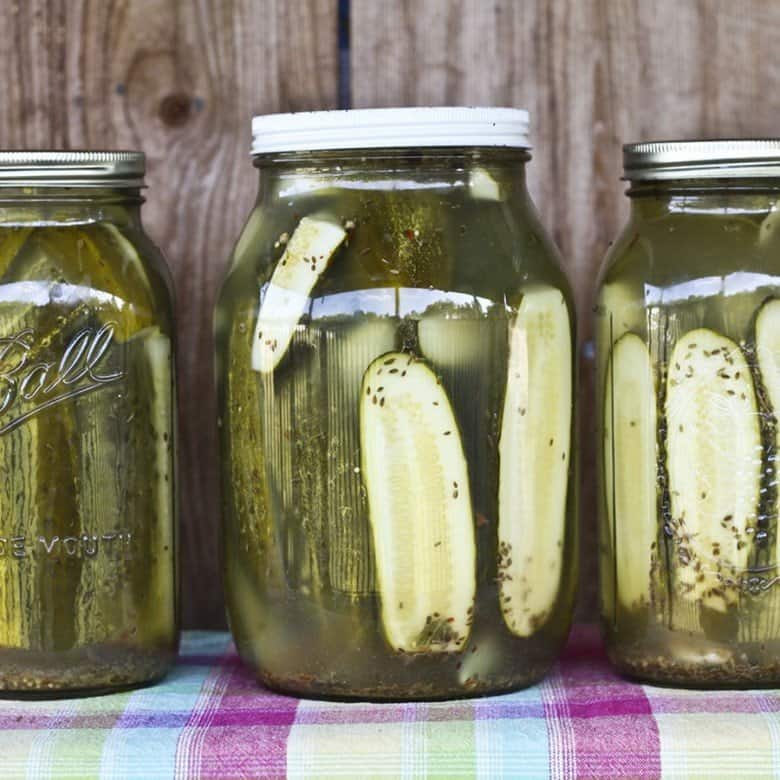
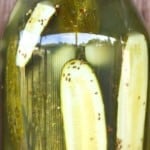



Reader's Thoughts...
Shane Peugeot says
Amazing Recipe! Look forward to more
William Greene says
Best pickles ever! I made a gallon to try, they turned out great! My wife loves them ! I have 2 gallons brewing now.
Rebecca says
Hooray! I’m so glad you like them!
Sue Hamilton says
We have our pickles sitting in the gallon jar but want to transfer, at some point, to the quart containers. Did I read something wrong? I don’t really want to eat them out of the gallon jar, plus they take up a lot of room in the fridge that way. What do I do? P.S. This is the first year we have attempted canning anything!
Rebecca says
You can absolutely switch them to quart containers. Feel free to do so right before transferring into the refrigerator!
Amy says
I’ve got about half a gallon of brine leftover – can I refrigerate it and use it when I have more cucumbers? Any other suggestions for using it? It smells so good.
Rebecca says
You can definitely refrigerate it and plunk more cucumbers into it!!!
Steven Seweryn says
Do not use McCormick pickling spice. This makes the pickles taste like corned beef. Keep it simple – garlic, salt, peppercorns, dill seed and mustard seed (optional).
Matt says
I followed the recipe to a T and mine turned out super salty, almost inedible. Should it be 1/3 cup of salt or 2/3 like the recipe says?
Rebecca says
Hi Matt- I’m betting you used a different type of salt. My recipe is geared toward Morton’s Coarse Kosher Salt. If you used any other brand, it may have been a finer grind which would mean you ended up with more salt in your brine. The recipe is accurate as written, and many people have been quite pleased with the results, so I think that may be the issue.
EZChef says
I made some measurements, using Diamond Crystal Kosher salt:
2/3 cup Salt = 90 grams.
1 gallon cold water = 8.344 lb. or 133.5 ounces, or 3,784.838 grams.
Your recipe makes a 2.4% salt solution, before adding the vinegar.
Is this what you want?
Since the weight of 2/3 cup of salt and the strength of the brine will vary with the size and density of the salt crystals used, the only way to get consistency of results is to weigh the ingredients.
Vinegar: I have never seen vinegar specified in any other recipe for Kosher style pickles! Won’t the vinegar inhibit the lacto fermentation process?
Rebecca says
Hi EZChef. I actually use Morton’s Coarse Kosher Salt which is a slightly different grind than Diamond. And as for the vinegar, it is a very small amount compared to the brine AND it is raw cider vinegar, so there is the mother to contribute to the party.
EZChef says
Rebecca:
Morton’s salt has a finer grind, so 2/3 cup weighs more than the same volume of Diamond Crystal, and yields a stronger brine. Do you know, what 2/3 cup of Morton’s weighs? With that number, I can calculate the percentage, for you.
I’ll try the vinegar (with the Mother) next time.
EZChef says
I did some more research, and I found some equivalents: 1 unit of table salt, by volume, = 1.5 units of Morton’s Kosher salt = 2 units of Diamond Crystal Kosher salt. Your recipoe makes a 3% brine solution, using Morton’s and 2.4%, using Diamond Crystal. This is stronger, than the 2% solution I’ve seen recommended, in most other recipes. Is this what you want? I have used a 2% salt to cabbage ratio, for sauerkraut, a dry salting process, very successfully, so I wonder…
EZChef says
I found a salt conversion table:
One Cup of:
table salt weighs 10 oz.
Diamond Crystal Kosher salt weighs 5 oz.
Morton Kosher salt weighs: 8 oz.
So:
2/3 cup of salt in a gallon of water makes:
a 5% solution, with table salt
a 2.5% solution with Diamond Crystal
a 4% solution with Morton’s
Jeanne Scott says
Can i ptepare these in a stainless soup pot and then transfer to jars for storage? If so, when in yhe orocess should I make the transfer?
Rebecca says
Hi Jeanne- I haven’t tried that, but I think it should work in theory. If I was to try it, I would transfer them to jars when I was about to stick them in the refrigerator. 😀 If you try it, please let me know how it works out for you!
LeaAnn Buckwell says
After making 4 1/2 gallons of these, I was absolutely sick when I opened a jar to taste. They were horrible!! The pickles were soft and I cannot describe the taste. DO NOT waste your time and money like I did. They may be easy, but they are not edible.
Rebecca says
It sounds like something went wrong with your batch, LeaAnn. That could have been caused by old cucumbers or using the wrong cucumbers, using cucumbers that had the blossom end left intact (which releases an enzyme that can soften the pickles), using iodized salt, or bad bacteria being introduced to the jar. Iodized salt can really ruin a batch of pickles! The other thing that can cause an issue like that is if you processed the jars instead of following instructions and letting them sit out at room temperature before transferring to the refrigerator. Any heat processing will destroy these pickles. It really is impossible to tell what went wrong having not been in the kitchen with you, but there have been so many happy people who have checked in after making these to share their results, so I would encourage you to try again but on a smaller scale!
davey says
That is hilarious that you would start out by making 4 1/2 gallons on a recipe that you never tried before! I applaud your level of blind confidence! Personally, I started out by making just 1 quart to see how they came out.
Tammy says
Can I use a coffee filter on top of pickle jar
Rebecca says
Absolutely, Tammy! I would advise you to keep extra brine on hand as it is likely to evaporate more quickly with a coffee filter. 😀
Amber Weber says
Hi! I went through all the comments before asking this question so you wouldn’t have to repeat yourself. 😉 Do you use coarse or fine kosher salt? I’ve made these a few times, but it’s been awhile. One of the times I made them, they were WAY too salty. I just don’t want to make the same mistake with the half bushel of cucumbers that were just given to me! 🙂
Rebecca says
Hi there, Amber! I use Morton’s coarse kosher salt, specifically. This is a link to what I use: http://amzn.to/2uT2PK3
Gwen says
Try adding a small piece of stick cinnamon and a few grains of fennel to your brine. Claussen does. I have made these refrigerator pickles for years. I put one head of dill in the bottom of each wide-mouth Ball jar, add the cucumbers and brine. Then, I put another dill head on top, and add a jar lid and ring. I keep the jars on the kitchen counter for 3 days but cover them with a clean dish towel as light affects the brining. The dill head on top pushes the cucumbers beneath the brine. Each day, I turn each jar upside down a couple times to redistribute the brine and seasoning. Then, I put the upright jars back on the counter and cover again. In 3 days, refrigerate. Mine keep for up to a year in the refrigerator without degrading.
Jenny says
I cut the recipe in half but still needed 4 quart jars. Will they still turn out ok?
Rebecca says
They should be fine! I’m not sure how cutting it in half still yielded 4 quarts, though! 😀
Brittany says
Hi there! I can’t wait to try out your recipe! I only have one issue. I don’t have a gallon jar on hand and I have a bunch of pint sized jars. I’m super new to canning and I’m not sure how I would go about dividing up the ingredients into a bunch of pint jars. If you could help me out I would be ever so grateful! Thanks in advance!
Rebecca says
Hi Brittany! You can certainly divide it between pint jars but that’s going to be a lot of work for you! I’d just go grab a flat of quart jars if you’re going to divide it up.That’ll be far less work 😀
Jessica Cook Slade says
Thanks so much for sharing your recipe! Quick question: I just finished pouring brine over the cukes, but had stirred the pickling spices in with the salt/water/vinegar. I have quite a lot of spices still floating in the leftover brine. I followed your directions as to stuffing the jar with cukes, garlic, and dill; then followed your direction to stir remaining ingredients together and pour over the cucumbers. Was I supposed to layer the pickling spices in BEFORE adding the brine? If so, should I drain the leftover brine and add the spices into my jar?
Thanks!
Rebecca says
Hi Jessica! I would skim the spices off the top of the brine and plunk them into the jars with the pickles. Reserve the extra brine to top off your jar if the levels drop!
Billy says
Thank you for your informative recipe! You make it sound so simple, and your pictures are great as well! Can’t wait to try this at home, it seems like something that I could do in an hour and have pickles for the next few weeks! My family would love it. Thank you again for sharing!
JoAnne says
I am from Ontario Canada and fell in love with Claussen pickles living in Minneapolis with my now ex who played for the Minnesota North Stars hockey team. Do you have a video of your recipe?
Rebecca says
Hi JoAnne! I do not have a video YET, but one is in the works!
Jenny says
Theses pickles are THE BEST! However, I put them directly in the refrigerator; they taste wonderful. The first batch I followed the procedure, but discovered they were just as good without worrying about the “foam”. Thanks for the recipe!
Rob at K and R Place says
God Bless you, lady! I made one large batch of those things, and about have to stand shotgun on the fridge when people come by! Many many thanks for a recipe I’ve been looking for, for a long time.
Today, I did a gallon jar of diagonal sliced chips…. I feel like a kid with a chemistry set…
Rebecca says
HA! People do kind of keep dipping back into the jar to grab more, don’t they? 😀
Lyn says
I am a bit confused by the size of the jar. If I use a gallon jar and use a gallon of water, won’t there be displacement caused by the cukes? Maybe I am missing something. Thanks!
Rebecca says
There will absolutely be displacement, but you may need to top off the brine now and again, so it’s good to have extra!
Leslie says
I made these last night and I can’t wait to try them! BUT….I made a booboo. I halved the recipe, because I was using 4-32oz jars, except I forgot to half the dill seed! I already had two of the jars made up before I realized what I had done. Have you ever used double the amount of dill?? I’m wondering just how bad the pickles will taste. 🙁
Rebecca says
I don’t think it will be bad at all, just different!